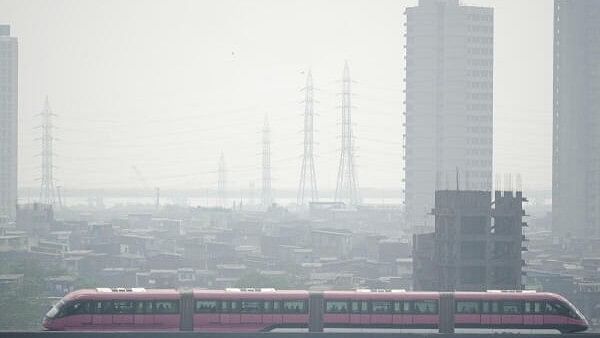
A monorail runs amid smog in Mumbai. (Representative image)
Credit: PTI File Photo
Mumbai: Maharashtra's cities, including economic hubs such as Mumbai, Pune and Navi Mumbai, continue to face significant air pollution challenges, according to a new report by Respirer Living Sciences Pvt Ltd (Respirer) based on data from the AtlasAQ Platform.
This comprehensive analysis of PM2.5 levels across key cities from 2019 to 2024 highlighted the mixed progress under India’s National Clean Air Programme (NCAP) and shows both improvements and persistent issues in reducing air pollution.
According to the latest report based on data from the AtlasAQ Platform, 10 out of 19 non-attainment cities in Maharashtra have shown rising PM2.5 pollution levels despite targeted interventions under the National Clean Air Programme (NCAP), according to a press statement.
Cities including Navi Mumbai, Aurangabad, and Jalna continue to exceed safe air quality limits, with Navi Mumbai recording high PM2.5 levels at 61.80 μg/m3 in 2023—well above the National Ambient Air Quality Standards (NAAQS - 40 μg/m3) and the World Health Organization’s (WHO - 5 μg/m3) guideline. Other cities include Thane, Badlapur, Ulhasnagar, Chandrapur, Jalgaon, Nagpur, and Solapur. With PM2.5 levels consistently exceeding the NAAQS, these urban centres remain heavily polluted due to factors including industrial emissions, vehicular traffic, and rapid urbanisation. Despite NCAP efforts to reduce particulate matter levels by 20-30%, these cities face persistent challenges due to industrial emissions, vehicular pollution, and rapid urbanisation, underscoring the urgent need for more robust pollution control measures in the state.
In contrast to the rising pollution trends seen in several non-attainment cities across Maharashtra, Mumbai and Nagpur have shown notable improvements in air quality over recent years.
Mumbai's PM2.5 levels dropped significantly from 49.75 μg/m3 in 2023 to 28.82 μg/m3 in 2024, moving closer to the National Ambient Air Quality Standards (NAAQS). Similarly, Nagpur saw its PM2.5 levels fall from 51.35 μg/m3 in 2023 to 40.53 μg/m3 in 2024. These improvements suggest that targeted pollution control measures in these cities, such as traffic management, industrial regulation, and enhanced public awareness, may be starting to have an impact.